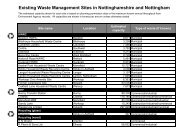Nottinghamshire Common Assessment Framework Handbook
Nottinghamshire Common Assessment Framework Handbook
Nottinghamshire Common Assessment Framework Handbook
Create successful ePaper yourself
Turn your PDF publications into a flip-book with our unique Google optimized e-Paper software.
Appendix K<br />
<strong>Nottinghamshire</strong> <strong>Common</strong><br />
<strong>Assessment</strong> <strong>Framework</strong> (CAF)<br />
Getting child/young peoples view for the<br />
CAF: some notes of guidance<br />
The My Feelings Colouring Chart and Number Line Tool have been designed to support practitioners<br />
in capturing the views and ideas of children and young people when using the <strong>Common</strong> <strong>Assessment</strong><br />
<strong>Framework</strong>. These tools should be used at the beginning of the CAF process to gain an understanding<br />
of their strengths and needs, then at the end to measure the impact of the changes made. It is<br />
essential that the views of children and young people are listened to at all times.<br />
The My Feelings Colouring Chart and Number Line sheets should be completed by the child or<br />
young person, with their views and ideas regarding each section noted by the practitioner on the<br />
Feedback Record.<br />
When using the CAF questionnaire you may want to consider some of the following as a possible<br />
introduction:<br />
“My job today is to help you to answer the question ‘How happy are you?’ The things we talk about will<br />
be used in the CAF (explain what this is) which is being carried out, and it is really important that your<br />
thoughts are included.<br />
Asking someone how happy they are is a very big question, and together we need to understand what<br />
being happy means to you. There are a couple of ways of doing this; one uses a target picture, and the<br />
other uses lines. Which would suit you best?<br />
The target/lines show some of the different ways in which people can be happy or sad. For example,<br />
someone might be happy at home but not at school; they may feel ok about their family but not at all<br />
happy with themselves.<br />
For each number line or segment of the colouring chart, I want you to think which of the three options<br />
best fits: so, for example, when you think about school:<br />
• are you generally happy there, sad there, or somewhere in between? (colour in the right part if the<br />
segment or circle the number)<br />
• what makes you feel like this?<br />
• if this were better, what would it look like?<br />
• what could you do or someone else do, that could make this happen?”<br />
The answers the child gives will provide the qualitative evidence to complement the quantitative<br />
evidence of their colouring in sections on the target or circling where they are on the lines.<br />
If you would like any further information regarding using the CAF with children, young people and<br />
their families, please contact the CAF team on 01623 433291 or by e-mail at: caf@nottscc.gov.uk



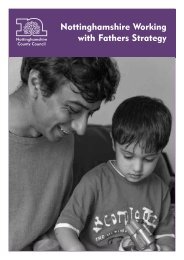
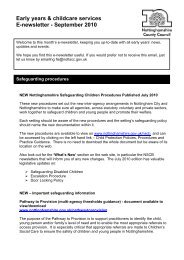
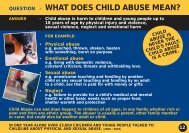

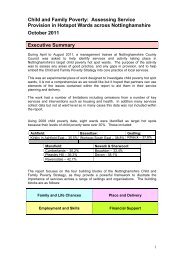

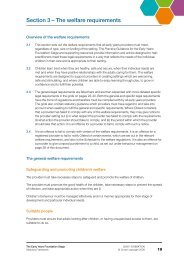
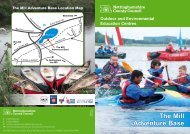


![Every Parent Matters [PDF 463KB] - Nottinghamshire County Council](https://img.yumpu.com/47250686/1/184x260/every-parent-matters-pdf-463kb-nottinghamshire-county-council.jpg?quality=85)
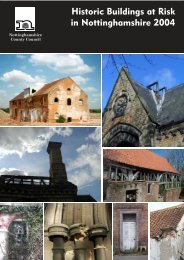

![School Employee Domestic Violence and Abuse Policy [PDF 228KB]](https://img.yumpu.com/46294446/1/184x260/school-employee-domestic-violence-and-abuse-policy-pdf-228kb.jpg?quality=85)
